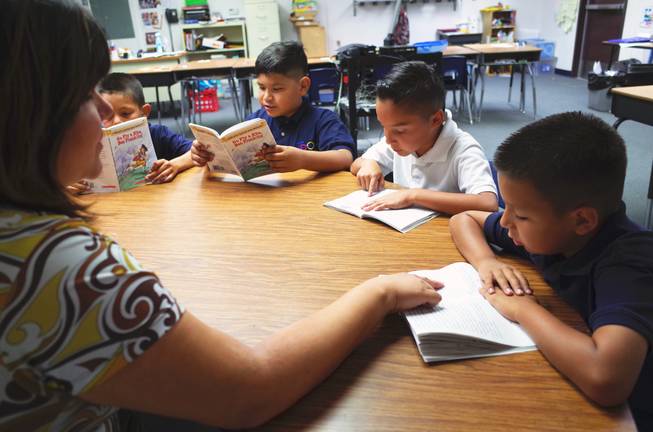
Cortez Elementary School teacher Shasta Thompson reads with third graders (l-r) Isaiah Corona, 9; Uziel Umana, 9; Rafael Lucio, 9; and Reily Armenta, 8; on Monday, June 22, 2014. Cortez is one of 14 “Zoom Schools” in Clark County that is receiving 17 additional days of school this year to help English-language learner students retain their literacy skills over the summer.
Tuesday, Oct. 28, 2014 | 5 p.m.
The baseline has been set for Superintendent Pat Skorkowsky’s five-year plan, and the data show the district still has a long way to go to reach its goals by 2018.
Last school year, Skorkowsky, with the support of the Clark County School Board, unveiled the Pledge of Achievement, highlighting six five-year goals that would improve a district that routinely ranks at the bottom of the nation in education. Those six areas include improving reading proficiency for third-graders, reducing achievement gaps, increasing graduation rates, more parent involvement, better student safety, and more college and career readiness.
The first-year results announced today were mixed. Some areas were close to the goal, while others, like the achievement gap, lag far behind the goal. Skorkowsky knows the district has a lot of work to do to improve. Still, he said, each year the results will act as a baseline that the district can build off with additional programs.
Skorkowsky joined a panel of community business members and educators to address the results today during a forum at Desert Oasis High School.
Here is a look at where the district is at in achieving its five-year goals:
-
Third Grade Reading Proficiency
2013-2014 Results: 60.3 percent of students were proficient in reading.
2018-2019 Goal: 80 percent.
This is one of the biggest areas of concern, Skorkowsky said. The later children are able to read, the more likely they are to fail in school. Yet students at low-income, low-performing schools are often much farther behind, said panelist Sylvia Lazos, a UNLV Boyd School of Law professor.
Programs like the Zoom School initiative to provide more resources and school time for students at schools with high English-language learners is a start, but more needs to be done for students in poverty, too, she added.
“We need to focus on how poverty is impacting our community and reading scores,” Lazos said. “Teachers can’t do it alone.”
-
Achievement Gap
Elementary School Math/Reading
2013-2014 Results: 19.8 percent gap/ 16.7 percent
2018-2019 Goal: 5 percent/5.4 percent
Middle School Math/Reading
2013-2014 Results: 30.3 percent/ 21.9 percent
2018-2019 Goal: 16 percent/ 8.2 percent
The largest gaps in proficiency exist most often between white students and black or Hispanic students. Skorkowsky said it will remain a focus of his to make sure all students have an opportunity to succeed.
Urban Chamber of Commerce President Emerita Hannah Brown said the school district needs more funding to educate its minority students. That funding would be used to help the children when they’re younger to keep them in school.
-
Graduation Rate
2012-2013 Results: 71.5 percent*
2018-2019 Goal: 82 percent
*2014 data have not been released.
While the school district needs to improve graduation rates, it isn’t far off from the national average of 75 percent. Panelist Magdalena Martinez, who is director of education programs for UNLV's Lincy Institute, felt confident the district could achieve its goal.
Improving the graduation rate will help eliminate cycles of poverty in the community. Yet the key will be in how it prepares students for post-secondary education, which will be a necessity if they are to find work.
“At the end of the day, a high school diploma is not enough,” Martinez said.
-
Parent Engagement
2013-2014 Results: 89.5 percent of parents who feel they have been informed about their child’s progress.
2018-2019 Goal: 93 percent
Skorkowsky said the district has made it a focus at its schools to get parents engaged. Online resources like Infinite Campus help to provide parents real-time updates about their child, while the district is working with teachers and principals to train them in involving parents.
-
Student Safety
2013-2014 Results: 79.6 percent of students reported feeling safe and happy at school
2018-2019 Goal: 93 percent.
Skorkowsky said the district is working to improve emergency preparedness responses at schools, and implement more anti-bullying measures. Yet schools can’t fix the issue alone. It requires attention both at school and at home, said Sandy Miller, former first lady of Nevada.
-
College and Career Readiness
2013-2014 Results: 25,438 students completed Advanced Placement or Career and Technical Education courses.
2018-2019 Goal: 31,580
Duncan Lee, businessman and Council for a Better Nevada chairman, said the district appeared to be making positive steps toward preparing its students for life beyond high school. He pointed out that the district expanded the magnet school program to seven schools and added more career-focused courses at four other schools. The next step is offering more resources at the middle school and elementary school levels to put them on a path for college and career readiness, he said.

Join the Discussion:
Check this out for a full explanation of our conversion to the LiveFyre commenting system and instructions on how to sign up for an account.
Full comments policy